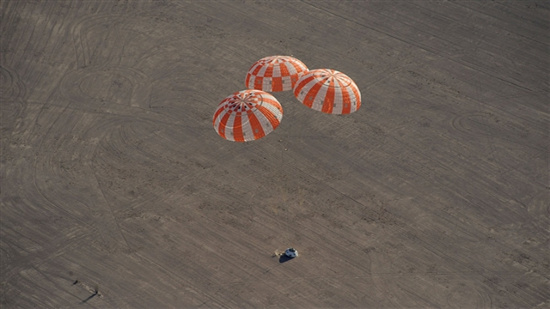People will parachute from ... the universe?
The US Aerospace Agency (NASA) is working hard to study how to bring astronauts back to safety when completing missions to discover strange 'lands'. One of these efforts is to find a way . parachuting from space.
The US aerospace agency (NASA) is planning to bring astronauts to the Moon, Mars and other asteroids, people will have the opportunity to set foot in the remote 'lands' outside the Universe. cylinder.
But there must be a return, but with the effort to take people far away, NASA is also working hard to research how to bring astronauts back to safety when completing missions to explore the region. That strange land. One of these efforts is to find a way . parachuting from space.
NASA recently conducted a test for the Orion spacecraft, on a mission to travel distant planets, using parachutes to land safely when returning to Earth.

Three main parachutes in the test
The test was conducted at the Yuma Proving Ground military test site in Arizona state. In this test a copy of the Orion spacecraft, with a volume of more than 9.5 tons, was dropped from a height of 7,620 meters (25,000 feet) in the sky with a total of five umbrellas.
In these five parachutes, three with a diameter of 35m will take on the main parachute task, the remaining two parachutes with a diameter of 7m will be auxiliary parachutes.
Under normal conditions, when landing, only two main parachutes and an extra parachute are opened as Orion ships can safely land. The main parachute and sub-parachute will work in emergencies when one of the three parachutes cannot be opened.
This test was conducted with the aim of testing the performance of spare parachutes. Accordingly the first funnel has been 'programmed' to make a mistake in the fall of the Orion model.
Only about 30 seconds after being dropped, the second funnel has opened and slowed down the speed of this spaceship model, effective enough to help the three main parachutes to release the falling ship. slow and safe.

NASA Orion spacecraft
Chris Johnson, director of the assembly project, although NASA's Orion, said: 'The spacecraft model landed safely at the right place and everything went as planned. We designed the parachute system to ensure that no incidents would occur, but we still had to plan and conduct trials to ensure Orion would be the safest ship to take people up. Space'.
The next test is scheduled to take place in February 2013, in which the complexity of the incident will be pushed up when one of the three main parachutes 'must' make a mistake. If tested to succeed as intended, it would be a step forward for scientists to get closer to the plan for the first experimental Orion spacecraft to fly in 2014. In the test. This, Orion will rise to a height of 5,794m above the ground, 5 times higher than the height of the International Space Station (ISS). The main goal of this experiment is to test Orion's ability to 'heat' in high-speed working conditions on Earth.
Orion is NASA's latest spacecraft with an ambition to take people further in the universe. Orion will return to Earth's atmosphere at a speed of more than 20,000 meters per minute. Therefore, one of Orion's difficult and vital requirements is to ensure the safety of the astronauts inside.
- The first one jumped out of an airplane at an altitude of 25,000 feet without a parachute
- Nearly die with a free fall with
- Mysterious person flies faster than Airbus 320?
- Why does the passenger plane have no parachute jump?
- NASA tested parachutes for the Mars mission,
- An Austrian will fly faster than sound
- The origin and evolution of the universe
- We live in the end of the universe
- 6 common anecdotes about the universe far from reality
- The most impressive findings about the universe in 2012 (2)
- The things you do every day will become very 'weird' when you are in the universe
- Bizarre service of burial of dead people to space
 Van Allen's belt and evidence that the Apollo 11 mission to the Moon was myth
Van Allen's belt and evidence that the Apollo 11 mission to the Moon was myth The levels of civilization in the universe (Kardashev scale)
The levels of civilization in the universe (Kardashev scale) Today Mars, the sun and the Earth are aligned
Today Mars, the sun and the Earth are aligned The Amazon owner announced a secret plan to build a space base for thousands of people
The Amazon owner announced a secret plan to build a space base for thousands of people Constellation Orion: The mysterious connection between interstellar civilization and ancient human civilization
Constellation Orion: The mysterious connection between interstellar civilization and ancient human civilization  NASA plans to have the first unmanned flight to the Moon in 2022
NASA plans to have the first unmanned flight to the Moon in 2022  Close up of testing process of rocket system on NASA Orion spacecraft
Close up of testing process of rocket system on NASA Orion spacecraft  Explore the Orion project - the secret plan of manufacturing spacecraft operated by atomic bombs
Explore the Orion project - the secret plan of manufacturing spacecraft operated by atomic bombs  Reveal shock of aliens building pyramids
Reveal shock of aliens building pyramids  Living on the space shuttle Orion is not as happy as you think
Living on the space shuttle Orion is not as happy as you think 